A boost towards productivity or a relaxing cup that brings warmth and comfort, coffee is a time-tested creation that can get you throughout the day. It is an ever-reliable beverage with a tempting aroma and a deliciously rich taste that you can enjoy solo or share with others on almost any occasion.
So, it comes as no surprise that the world consumes around 400 billion cups of coffee every year. Whether hot or cold and regardless of the reason, coffee is well-loved by millions of people. But have you ever wondered where our coffee came from and how it ended up in our cups?
Let us go on the journey of coffee production starting from its origin.
Origin of Coffee
Coffee is widely grown across the globe, but its roots trace back to the plateaus of Ethiopia. One legend tells a story about a goat herder who discovered coffee berries through their energizing effects on goats after consumption. This knowledge about the energy-giving berries quickly spread and reached the Arabian peninsula, where the worldwide journey of coffee began.
The roasted coffee that we know originated in the same peninsula, where its popularity soared during the 1200s. Then, coffee made its way into Europe around the 1600s and reached a new level of popularity. Along with this, coffee plants became more widespread than ever and were grown in other regions of Asia, Central America, and Brazil. By the late 1800s, coffee had finally become a worldwide commodity.
Types of Coffee Beans
Now we know how coffee originated but did you know that coffee has numerous types of beans? Each type of coffee bean has unique characteristics that can cater to our varying palettes. However, only two types of coffee beans are mainly grown today: Arabica and Robusta.
Let us first take a look at Arabica coffee, which came from the Coffea arabica plant originally found in Ethiopia. These beans have a pleasant acidity and slightly sweet taste, often with chocolate-like, nutty, and fruity notes. Due to these qualities, arabica is the most popular and sought-after coffee type and makes up 60-70% of the world’s coffee production.
On the other hand, Robusta makes up the remaining 30-40% of coffee production. Robusta coffee beans come from the Coffea canephora plant which originated in central and western sub-Saharan Africa. It has a more bitter and earthy flavor due to its higher caffeine content and is often used in instant coffee and espresso blends.
Cultivation
Coffee production starts at farms and plantations. For arabica farms, elevated locations starting from 600m above sea level are ideal for growth and cultivation. Arabica plants are sensitive to pests and harsh conditions, preferring humid subtropical climates with temperatures of 15-24°C. These delicate plants can also take 4-7 years to fully mature.
Unlike the arabica plant, robusta is hardy and resistant to numerous diseases and pests. These resilient plants also mature 2 years earlier, grow in lower altitudes, and can withstand temperatures of 30°C and above. Proper hydration is the main requirement for keeping robusta plants happy and healthy.
At present, Brazil is the leading producer of coffee. The country exports approximately 2.6 million tons of coffee each year, which makes up 40% of the world’s coffee production. Arabica coffee also accounts for 70% of Brazil’s coffee production. Vietnam follows Brazil and accounts for 20% of the coffee production. Mainly producing robusta coffee beans, Vietnam exports 1 million tons of coffee each year. Other strong competitors in coffee production include Colombia, Indonesia, and the origin country of coffee, Ethiopia.
Harvest and Coffee Processing
After maturity, coffee plants produce fruits called coffee berries. Harvesting these berries can be done manually or by using mechanical harvesters. Manual handpicking is the most reliable method of harvest. While the mechanical method is faster, handpicking allows farmers to select coffee berries in optimal maturity, which leads to a higher-quality harvest.
Obtaining the beans from harvested coffee berries requires processing to remove the covering and pulp. There are two common methods of processing coffee: the dry process and the wet process.
First, we have the dry process, also known as natural or unwashed. The dry process is the oldest method of processing coffee. This simple method tends to utilize sun-drying and requires little machinery. After coffee berries are sorted and cleaned, they will be placed under the sun to dry for several days. Frequent raking during drying is essential to prevent molds and fermentation. The berries must reach 12-13% moisture content before hulling. Since moisture affects coffee quality, drying properly and reaching the ideal moisture content are crucial to achieving high quality.
Related: Importance of Moisture Content in Coffee Processing
Drying solutions like the Collapsible Dryer Case can be a handy tool for dry coffee processing. The case is a portable sun dryer with inflatable walls to prevent contamination and effectively lessen spillage. However, its most important feature is its foldability which adds protection by avoiding the re-wetting of coffee beans due to unpredictable weather.
Meanwhile, the wet process or washed involves more steps and machinery. Normally reserved for higher-quality coffee, this expensive process results in fewer defects and better preservation. Newly harvested coffee berries are immersed in water to separate the floating unripe ones from the ideal ripe ones settling below. After which, the coffee berries undergo machine pulping and fermentation to remove all layers of pulp. The resulting coffee beans are washed and dried to 11-12% moisture content.
Storage and Transport
Now we have our newly processed coffee beans or what we normally call green coffee beans. These sensitive coffee beans are ideally transported to their destinations or roasted and consumed as soon as possible. Coffee storage is always possible but can be challenging, especially in the environment of many coffee-producing countries. Warm temperatures and high humidity promote oxidation and mold growth that can damage coffee beans. Thus, proper storage is crucial and as essential as other processes to the quality of coffee.
Related: Best Practices in Storing Coffee Beans
Both airtight and moisture-proof, hermetic storage is ideal for prolonged coffee preservation. One great example is the GrainPro® Hermetic Bag™, a reliable hermetic inner liner for jute bags that consistently inhibits mold growth and infestation. Its opaque color also provides UV protection to further ensure that coffee beans are safe during storage and throughout transport. For large capacities, the GrainPro® Cocoon Indoor™ is ideal for long-term indoor coffee storage. This lightweight and airtight pouch can accommodate and preserve green coffee beans stored in boxes, jute bags, and big bags.
Encountering risks and delays during transport is always a possibility. Additional hermetic protection can be vital to preserving coffee beans during unexpected issues. Lining the container with GrainPro® TranSafeliner™ will prevent excess moisture and temperature fluctuations from affecting coffee beans during the long journey.
Thus, we have concluded our very own journey into coffee production. Whether the coffee beans end up in our favorite cafes or instant coffee makers, careful handling is a must throughout the process. Opting for reliable and innovative post-harvest solutions is highly important in maintaining great quality from origin to destination.
To learn more about GrainPro’s superior post-harvest solutions, click the button below.
Date Published: October 1, 2024




